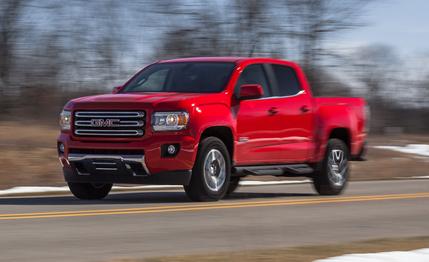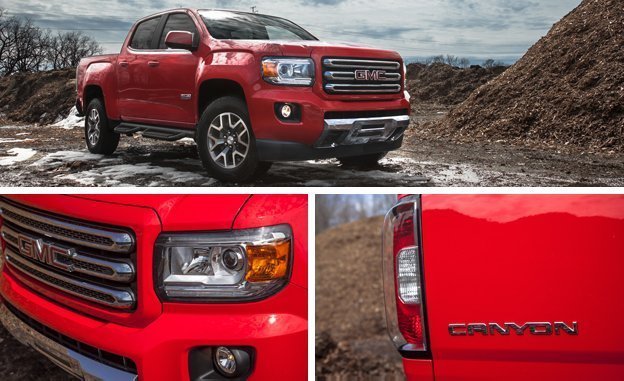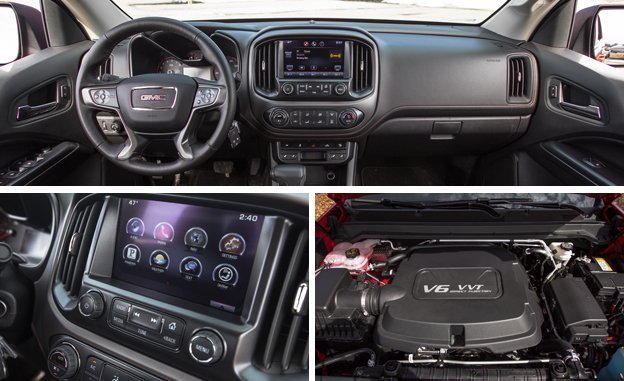 Instrumented Test
Instrumented Test
We know the new GMC Canyon is a small(er) pickup truck, which should make it a little cheaper to buy and operate, a little handier to maneuver in urban and suburban environments, and a little more sensible for use as daily transportation than full-size trucks. But it also provides an illustration of the elasticity of the word “small.”
Our impressions were based on a crew-cab Canyon with the short (62-inch) cargo bed, which checks in with a 128.3-inch wheelbase and at 212.4 inches long overall. With the biggest, 74-inch cargo bed, the wheelbase expands to 140.5 and overall length to 224.6, almost exactly as long as the long-wheelbase GMC Yukon XL full-size SUV.
We have indeed observed in other reports that the new Canyon and Colorado, its near-identical Chevrolet cousin, are wieldier around town than their bigger teammates. But if the Colorado and Canyon are not unwieldy, they’re not exactly handy, either. Getting the Canyon into and out of snug supermarket parking slots requires a little backing and filling—it’s rarely a one-move process—as the turning circle for our test truck is 41.3 feet.
Of course, none of the few still engaged in this area of the pickup-truck trade—Honda, Nissan, Toyota, General Motors—would seriously use a term such as “small” to describe their products. They’re mid-size trucks; it’s just that mid-size is now the low end of the scale and these personal trucks are not exactly wraiths. (At least until Hyundai’s Santa Cruz arrives.)

There are currently two Canyon engine options. The standard is a 2.5-liter four with 200 horsepower and 191 lb-ft of torque, while the step-up engine is a 3.6-liter V-6 making 305 horsepower and 269 lb-ft. A six-speed manual can be had with rear-wheel-drive 2.5 models, but everything else, including our V-6 truck, uses a six-speed automatic. A turbo-diesel six option is on the horizon but not until model year 2016.
As you’d expect, the four gets better EPA ratings—19 mpg city and 25 highway with 4WD, while a 4WD V-6 like our example is rated at 17/24. (We logged 17 mpg without pushing the truck very hard.) But the six-cylinder is the only choice for owners planning to exploit the Canyon’s 7000-pound towing capability, and it’s also a better choice for getting across the intersection when the light turns green. Running from zero to 60 mph in 7.5 seconds, it emits a guttural growl while going about its business; as exhaust notes go, this one qualifies as an acquired taste.
The six-speed automatic is nicely programmed for up- and downshifts in full auto mode, with no unwarranted hunting and prompt kickdown when the driver tramps on the accelerator pedal. It does have a manual function, which most drivers will try once or twice and then forget except, maybe, when towing up or down steep grades.
Ride quality on patchy pavement can be a little abrupt, which isn’t surprising for a vehicle with spring rates designed to accommodate 1500-pound payloads, not to mention our test truck’s $1190 All-Terrain package (Z71 suspension, 17-by-8-inch wheels, all-terrain tires, transfer-case skid plate, hill-descent control, power-operated heated front seats). It’s harder to forgive the electric power steering, which is both slow (3.2 turns lock-to-lock) and numb. We also noted a fairly noisy wind leak somewhere on the right side of the cabin, although GM has done a good job of damping out road noise.

Braking is another dynamic category where the Canyon could be better. Stopping distances from 70 mph—187 feet—aren’t exactly bragging stats, although the off-road-ish tires are a factor here. Plus, our test crew noted fade after repeated hard stops.
The inner Canyon is nicely turned out, however, and looks a little more like what you’d expect in a truck costing almost $40K—a little better appointed than a corresponding Chevy Colorado, for example. Our 4WD SLE test truck was kitted out with $4155 worth of options. Besides the All-Terrain package, the list included a $745 set of tubular step rails that we strongly suspect were designed by someone who owns a chain of dry-cleaning stores.
Be that as it may, the as-tested price here begins to stretch the Canyon’s prime raison d’être: affordability versus full-size pickups. The mid-size pickup fell out of favor when potential buyers realized they could get into a full-size truck for similar money. Rising prices for the big boys inspired GM’s mid-size return, and the Canyon should satisfy the demands of its target audience. It is capable, looks good, has respectable performance, has a good work ethic, is solidly built, and yes, is more tractable than a full-size truck for owners who will be using it essentially as an all-around SUV with an open cargo bed.
Just be conscious of the ol’ bottom line.